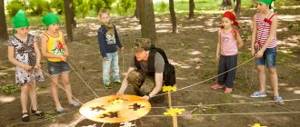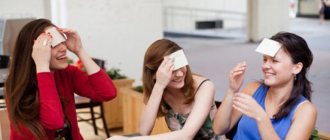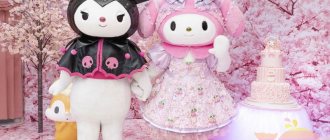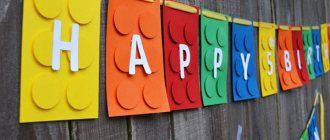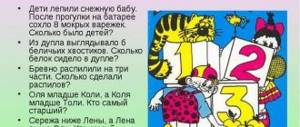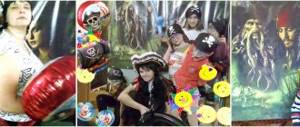Quest game in kindergarten for older preschoolers. Preparatory group
Quest game for preschoolers “Searching for a hidden surprise”
Author: Pochaeva Tatyana Anatolyevna, teacher-psychologist MBDOU “Kindergarten No. 2”, Konakovo Description of the material. I offer you a summary of the final lesson of a teacher-psychologist with children in the preparatory group for school. This material may be useful to preschool psychologists, teachers of senior and preparatory groups, as well as parents of preschoolers and students in grades 1-2. It can be used with a group of children of different ages, since the tasks are not difficult, but require intelligence, observation and attention. Integration of cognitive areas: “Cognition”, “Communication”, “Socialization”, “Reading fiction”. Goal: Summarizing the work of a psychologist with children of the preparatory group in a playful way. Objectives: Educational: To consolidate in independent activity the ability to find differences between objects, classify, and identify patterns. Provide an opportunity to apply the acquired knowledge and ability to work according to instructions in a game situation. Developmental: Develop concentration in a situation of a large number of distractions; the ability to quickly update your knowledge of the world around you. Educational: To develop a friendly attitude towards peers, the ability to work in a group, the ability to make contact and express one’s requests. Demonstration and handout material: - postcard for starting the quest,
— picture “Find 7 differences”,
— pieces of the “Refrigerator” puzzle,
- rebus,
- “What’s extra?” - image of a ladybug,
- small mirror, - “Chamomile”,
- "footprints". Methodological techniques: game situation, summing up. Conducting a quest game. To start the game, preparation of the premises is required. In our case, the game began in the group room, so the children left their group with the teacher for 10 minutes. During this time, the educational psychologist placed a postcard to start the game and placed the puzzle pieces in certain places. After this, the children returned to the group. Teacher-psychologist: “Today we have our final psychological lesson. It will be longer than usual and will last 40 minutes, which is exactly how long a lesson lasts at school. You will work together and individually, try to be attentive from the first minute so that you do not waste time repeating instructions. The tasks are not difficult, but there are a lot of them, and all of these tasks must be completed within 40 minutes. If the group succeeds, a surprise awaits everyone. Our lesson will be held in the form of a quest game. Quest is an adventure game. Having solved one task, you receive a hint where to look for the next task. And at the end you get access to a surprise. Look at your watch. They show 9 hours 20 minutes. At exactly 10 o'clock the game should end. Time has passed. Look around the room carefully. You should see the first hint. It stands in a prominent place, bright and shiny. The first one who sees it comes up, takes the clue and gives it to me.” The children carefully examine the room and discover a postcard with the first task included. Educational psychologist: Task 1 “Find the differences.” On this sheet you see two identical, at first glance, pictures. But there are 7 differences between them. These differences will help you find the next clue. (Distribute pictures to children in sufficient quantities so that each child has the opportunity to compare and search). Who saw the first difference? What is the difference? Children's answers. Educational psychologist: “You saw that the flower is different, so look for a piece of the puzzle there. In total you need to find 7 puzzle pieces and put them on the table (show where). Children name the differences: “Pillow, bedside table, rug, window sill, sofa, flower in a vase, floor lamp (I replaced it with a table lamp).” When all the fragments are found, the second task is performed. (The children in one group completed the first task very quickly, in the other group they could not find a piece of the puzzle hidden on the bedside table for a long time, because they mistook another piece of furniture for a bedside table, so the leader had to tell them what the bedside table was). Task 2 “Fill the puzzle.”
Despite the fact that the children are good at putting together puzzles, difficulties arose at first. Nevertheless, they put the puzzle together and saw that the arrow was pointing to the refrigerator. Educational psychologist: “Think about where you can find a refrigerator?” Children's answers: “In the kitchen.” Educational psychologist: “I suggest you go down to the 1st floor and go to the kitchen.” Nina Vasilievna (the kitchen worker) comes out, the children explain to her that they want to see the refrigerator in the kitchen. She invites the children to first guess the riddle: Who cooks cabbage soup, cutlets, Borscht, dumplings, vinaigrettes;
Cooks porridges and compotes, Fries entrecotes in oil, Mashes potatoes with a masher, Stirs soup with a ladle? Children's answer: cook.
Children enter the room, examine it and find a riddle (this is the third task): “We have a robot in our apartment, It has a huge trunk.
The robot loves cleanliness And hums like a liner: “Too-oo-oo”, Swallows dust with great eagerness, But does not get sick, does not sneeze.” Children's answers: this is a vacuum cleaner.
Educational psychologist: “Think about where the vacuum cleaner might be? What is it for? Children's answers: a vacuum cleaner is needed to vacuum carpets. Teacher-psychologist: “Remember in which rooms of the kindergarten you saw carpets?” Children's answers. To test their guess, children go in twos to the music room, to the gym, to the dry pool room, etc. Everyone else, along with the psychologist, is waiting for their return. Under the vacuum cleaner, the children discover another clue in the form of a rebus, after solving which they understand that their path lies in the laundry room. The children are greeted by the kindergarten laundry worker. She asks a riddle: “It strokes everything it touches, and if you touch it, it bites.”
In the ironing room, children receive task sheets and return to their group.
Educational psychologist: “You received sheets on which you need to find extra objects that will tell you where to look for the next clue.” Task 5 “What’s extra?” (Answers: a saucepan, a cup, a book, an umbrella, a balloon, a camera. Pictures depicting ladybugs are hidden in or near these objects. Since there are many children in the group, there were 2 saucepans, 2 cups, etc.) Task 6 “ Ladybug"
When all 12 ladybugs are found, the educational psychologist shows hers. Children must find exactly the same one among the ladybugs found. Task 7 “Read the word”
On the back of the “correct” ladybug (second copy) the word is written in a mirror image. This is the word closet. Task 8 (individual) There are sheets of assignments in a folder in the closet. They are of varying complexity. For speedy distribution, the sheets are signed. Children complete tasks; if they do not understand what exactly needs to be done, the leader and teachers explain the instructions.
Tasks are completed at tables. Task 9 “Chamomile”
While the children are solving “Chamomile,” the psychologist’s assistant lays out “traces” that will lead them to the surprise. This is where the game ends. A photo is taken for memory.
Afterword. The game took place in two preparatory groups. The first group easily completed the allotted 40 minutes. The children acted quickly, successfully, and completed all the tasks of the quest without prompting. The second group worked separately, each child wanted to personally complete the task, was upset if he was not the first to find the correct answer, etc. In order to meet the 40 minutes and get to the surprise, I had to skip individual tasks. All the children tore off the “Chamomile” petals with questions. If they could not answer a question on their own, the group helped. The children and teachers of both groups really liked the quest game.
We recommend watching:
Summary of the final lesson on FMP for children of the preparatory group. Summary of the final lesson of GCD in the preparatory group for school. Summary of the final lesson for children 6-7 years old in the “School of the Future First-Grader” Game activities in the preparatory group of the kindergarten
Similar articles:
Lesson “Travel through fairy tales” in the preparatory group
Master class “Ancient map for a quest game”
Anna Morozova
Master class “Ancient map for a quest game”
Currently, quest games have become very popular . But, as we know, in a quest, not only the content is of no small importance, but also colorful, bright attributes. The attributes must be aesthetic, adequate to the tasks and theme of the game. When using paraphernalia, interest in gaming activities increases many times over, and the degree of “immersion in the game” increases.
The master class will show the easiest way to make and “aging” one of the necessary attributes in the quest - movement cards . Our map today was designed for an adult pedagogical quest - “Sea voyage through the islands of gaming technologies.”
We will need a few materials : whatman paper size A3, pencil, eraser, ruler, brown felt-tip pen or marker, candle, several bags of black tea, instant coffee, bowl of water.
On whatman paper we mark the location of the objects with a pencil (for us these are islands, on the edges of the sheet we selectively draw triangles with the point inward - these will be the future frayed edges of the old map. You can cut off the edges of the corners a little here and there.
Cut out our uneven edges.
Brew black tea (3-4 bags to make it stronger, wait for it to cool slightly, pour it into a basin. Well, now the worst part - dip the Whatman paper directly into the tea and thoroughly wet the leaf so that it is thoroughly soaked. Hold until will be painted in the desired tone - darker or lighter.
We mean that if you take thin paper for a map, and not whatman paper (for example, photocopy paper), it will simply unravel. Therefore, we take whatman paper and are not afraid of anything.
If the paper gets slightly wrinkled while you are soaking it, it’s okay, it’s probably even better - it will add abrasions and color to our map.
When the Whatman paper reaches the desired condition, take it out and lay it out on a flat surface.
To make the card appear old, with uneven coloring, we will add specks: lightly sprinkle the future card with instant coffee granules. The coffee will begin to dissolve and spread on the wet surface, and the very stains that we need will form. If the stains are too large or bright, you can easily blot them with a napkin. You shouldn’t try to be too careful – in this case it will only get in the way.
Next, the card needs to be dried on this surface. To speed up the process, you can place paper towels under the Whatman paper and use a hairdryer.
Next stage: to age the edges and corners of the card, giving them the appearance of time-worn, smoked from torch fire, we use a candle. To make the edges of the card darken, hold candles above the fire at a distance of 3-4 cm. To char, carefully run the edge of the card directly over the flame.
Don’t forget to place a damp old towel nearby - if you overexpose the edge and it starts to catch fire, you can quickly press the smoldering part with the towel.
The map is almost ready! We outline the intended drawings with a felt-tip pen, add path lines, and mark landmarks if necessary.
In general, this is the most creative part, where your imagination can run wild.
This is what we got!
It took me 1 hour and 10 minutes to make 2 cards.
Thank you for your attention!
Quest game “Journey to the Land of Feelings”
Abstract of an open lesson in sub.gr
"Journey to the Land of Feelings."
educational psychologist Totmyanina M.S.
Goals
: the formation of adequate emotional states and manifestations in contacts with the outside world.
Tasks:
1. Teach children to analyze their internal state and the state of other people.
2. Develop empathy, desire and willingness to help other people.
3. To develop in children the skills of cooperation and cultural communication.
4. To develop the skills of voluntary movements through psycho-gymnastics.
Preliminary work:
- classes to familiarize yourself with various feelings and their significance in the life of every person;
- consideration of situations related to the expression of various feelings;
— games and exercises for emotional and personal development;
- familiarization with the ways in which you can express emotions (facial expressions, pantomime, to music, using color).
Materials:
a ball of thread, “a letter from the king”, a map - diagram of the Land of Feelings, a table, circles-plates of different colors, toothpaste, wet wipes, a chest, a gate, keys, a “wall”, portraits of children expressing different feelings, layouts of traces of feelings, cut portrait of the king, sheets of colored paper, audio recording.
The lesson is aimed at the formation of an age-related mental new formation - personal self-awareness, including awareness of one’s own personal qualities and abilities.
Progress of the lesson.
Psychologist:
“Guys, I suggest you sit in a circle. And as always, we start our lesson with the game “I Like You.” Now we will all together form one big colored web that connects us to each other. When we weave it, each of us can express our kind thoughts and feelings that we feel towards our peers. So, wrap the loose ends of the woolen thread twice around your palm and roll the ball towards one of the guys, accompanying your movement with the words: “Lena (Oleg, Maxim)! I like you because... (it’s very fun to play different games with you).”
Lena, having listened to the words addressed to her, wraps the thread around her palm so that the “web” is more or less taut. After this, Lena must think and decide who to give the ball to next. Handing it over to Oleg, she also says kind words: “Oleg! I like you because you helped me find my bow that I lost yesterday.” And so the game continues until we are all entangled in the “web”. Then we all admire the resulting thread pattern together, let the thread slip from my hand, and I wind the ball.
The purpose of this exercise is to develop communication skills and good relationships between children.
Quest game as a means of developing cognitive abilities in children of senior preschool age
Quest game as a means of developing cognitive abilities in children of senior preschool age
The problem of forming cognitive activity in children of senior preschool age is one of the pressing pedagogical problems today. Every teacher knows that a child will not be able to successfully master the material if he is indifferent to knowledge, therefore cognitive activity in preschoolers must be formed and developed.
Features of the development of cognitive activity in preschool age are that the cognitive activity of a child of senior preschool age
characterized by the optimality of attitudes towards the activity being performed, the intensity of mastering various ways of positively achieving results, the experience of creative activity, and the focus on its practical use in one’s daily life.
Quest (from the English “quest” - challenge, search, adventure) is an intellectual type of gaming entertainment, during which participants need to overcome a number of obstacles, solve certain problems, solve logical riddles, cope with difficulties arising on their way, in order to achieve a common goal. goals
A quest game as a means of developing the cognitive activity of children of senior preschool age simultaneously promotes the development of the participants’ intelligence, their physical abilities, imagination and creativity, ingenuity, observation, resourcefulness and quick wits. Participants learn to negotiate with each other, distribute responsibilities, act together, worry about each other, and help. All this contributes to the unity of not only the children’s team, but also the parent community, and also improves parent-child relationships.
We propose to consider a quest game for children of senior preschool age “The Lost Laboratory”, the purpose of which is to develop cognitive abilities, demonstrate independence and initiative in children during the game and various types of activities.
To carry out the following equipment is required: emblems, cardboard templates of test tubes and flasks with
numbers on them from 1 to 10;
envelopes with tasks, balls with riddle notes, white sheets with numbers from 1 to 10 (drawn with a candle), gouache, brushes;
laboratory equipment: plastic spoons, chopsticks, baking soda, vinegar, water; bags filled
leaves, 2 keys on ribbons, maps - plans, with the route.
During the game, the children are accompanied by the “Professor” and offers several tests to get into
“The Lost Laboratory”, for this children need to pass tests using map plans.
1. Test “Tree of Mysteries” - about natural phenomena
2. “Magic sheets” test - children must use colored water to find numbers
3. Test “Arrange the test tubes and flasks”
4. Find the Key Challenge
In conclusion, the children use the keys to find the lost laboratory and the Professor demonstrates experiments with water, soda and vinegar to make “Colored Foam”.
So children, using various clues, solving puzzles, overcoming obstacles, find the initially proposed task.
Important! A quest is entertainment, so you don’t need to take everything that happens in it to heart, get upset if you lose, quarrel with friends if something doesn’t work out, be afraid, be nervous and complicate everything. You just need to enjoy the process and the atmosphere. And then the final main goal of participating in the quest – getting a sea of positive emotions – will be achieved!

